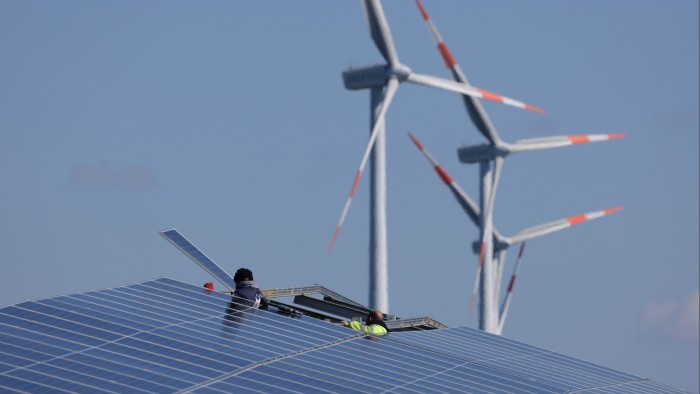Legal expertise is crucial to cutting through renewables deadlock


Roula Khalaf, Editor of the FT, selects her favourite stories in this weekly newsletter.
The author is an FT Lex writer
If the world succeeds in reaching net zero carbon emissions by 2050, it will be because countless individuals have thought up new ways to get things done. Among them are lawyers. Work related to environmental, social and governance issues is a growing part of the revenue stream for law firms, and is expected to increase rapidly as the energy transition gathers pace.
Achieving net zero carbon emissions by 2050 is a huge ambition. It requires mobilising almost $200bn of investments to transform how we produce, transport and use energy. Key strangleholds in this process are financing and permitting for projects, with lawyers helping their clients overcome delays and bottlenecks.
One piece of financial plumbing the energy transition badly needs is a way to connect the money investors have earmarked for green or sustainable investments to the companies and projects that need it.
Sustainability-linked loans (SLL) are crucial to this endeavour. In essence, companies can borrow money at more favourable terms if they pledge to hit environmental, social and governance targets. They need to report their progress and, if they fail to meet their objectives, the cost of the debt increases.
These are helpful instruments, encouraging all sorts of companies — even those not directly involved in producing renewable energy — to clean up their act.
The fly in the ointment is that issuing SLLs is a complicated process. The documentation that companies provide, explaining their baseline, targets and how progress will be measured, takes a lot of work to pull together. There is also little in the way of a common practice, so issuers have been as detailed or wishy-washy in their explanations as they can get away with.
That is the problem Sukhvir Basran, a partner at law firm Cadwalader, Wickersham & Taft, set out to solve. Through consultation with financial institutions and trade associations, she has created a model of what the terms and conditions for an SLL should look like. This points companies to the level of disclosure and detail required. It is also in plain English, meaning that even smaller issuers without access to sophisticated legal advice can use it to access this market.
“The feedback so far has been extremely positive,” says Basran. “The model provisions are already helping lenders, corporates and advisers to structure SLLs efficiently and scale sustainable finance solutions.”
Other legal teams have been working directly on project financing. When banks lend to projects, rather than companies, they rely on those specific future cash flows to repay debt. That means they need to price the risk of construction delays and cost overruns, and assess the project’s profitability once it goes into production. This is relatively easy for them to do when confronted with regulated infrastructure in developed markets. But it can be difficult to raise project financing when ventures are in a nascent market or located in developing countries.
Law firm Bracewell has had to tackle this challenge. When Infinity Power, a joint venture between Egypt’s Infinity and Abu Dhabi’s Masdar, bought Lekela Power — Africa’s largest renewables company — earlier this year, it was hired by South African bank Absa and Mauritius Commercial Bank to help arrange project financing. It was no easy task. Lekela has 1GW of wind assets across South Africa, Egypt and Senegal.
The banks had to get comfortable with the political and economic environment of the different countries, in which revenues are denominated in different currencies.
More on FT.com: Best practice case studies
Read the FT Innovative Lawyers Europe ‘Best practice case studies’, which showcase the standout innovations made for and by people working in the legal sector:
That Bracewell succeeded in raising project financing — considered a first for an asset of this kind in Africa — opens up another source of liquidity to power the growth of renewables on the continent. This is badly needed. African renewable capacity is set to grow from 54GW in 2020 to 530GW by 2040, according to the International Renewable Energy Agency.
Another major hurdle for companies seeking to ramp up renewables production is the permitting procedure for projects and the connecting infrastructure. In the UK, for instance, onshore solar and wind projects take about three years to get through the process, says Gareth Phillips, a partner at Pinsent Masons. Why not get developers to co-ordinate and cut costs and time?
Phillips explored this option by approaching separate developers, Island Green Power and Low Carbon, which have plans to build adjacent solar parks in Lincolnshire, eastern England, alongside other local developers. He secured a mandate to advise on the Development Consent Order process and has supported the developers in sharing plans, research and proposed access to land and transmission infrastructure.
As a result, the projects were able to whittle down their anticipated infrastructure to proposals for a single cable corridor, where four might have originally been required — which should save money and time by avoiding duplication of legal work.

Comments